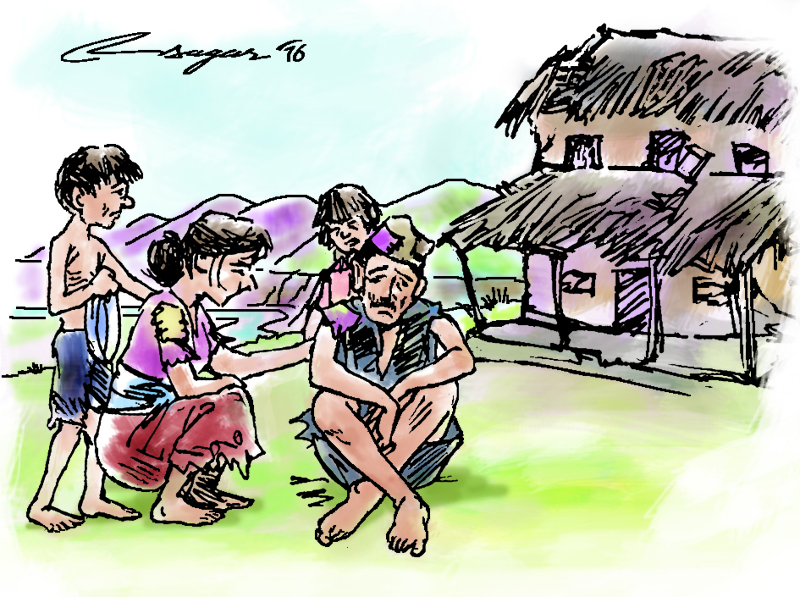Reduced poverty: Much neglected
A progressive distributional policy together with the suitable institutional setups and arrangements at the grassroots for ensuring exclusively the access of poor to social and physical infrastructure as well as financial services is also a necessity
As a part of global event, poverty eradication day was celebrated in Nepal recently with claims that Nepal is one of the best performers in this area. If estimated poverty trends are looked into, there are no grounds to refute such an assertion.
According to official figures, in 20 year’s period poverty has reduced by more than 20 per cent, from 41.8 per cent in 1995/96 to 21.2 per cent in 2015/16. Compared to the average GDP growth rate of 3.7 per cent in that period, the poverty reduction rate was about 3.2 per cent per annum.
The breakdown by different updated poverty estimated periods give an interesting pattern. For instance, the annual poverty reduction rate was sharpest at 3.7 per cent annually during 1995/96 to 2003/2004, surpassing the growth rate.
This was the period when the country was trapped in deeper conflict. The latest poverty estimates further show that the reduction rate was equally high at 3.2 per cent during the period 2012/13 to 2015/16, higher than the growth rate.
Noticeably, this was the period when more than 7 lakhs earthquake affected people were additionally pushed below the poverty line as pointed out officially at that time.
Too much rhetoric or thrust, poverty is still a much neglected area, treated in isolation and tautological way without making it an integral part of our development discourse.
More worryingly, still the official poverty estimates are consumption based which have been termed as obsolete since long.
Though for easiness and data reasons these are used for international comparisons, from a country’s standpoint such an approach overlooks the complex poverty and underdevelopment related factors and thereby misleads the policy discourse.
For instance, if consumption based poverty of 2010/11 is looked into, it is seen that about 60 per cent of the lowest quintile groups having only 24.1 per cent of income consume around 34 per cent of total consumption.
From the income side, more than 40 per cent of the lowest income group earn less than poverty threshold income of NRs 19,261 and hence unlike the consumption based poverty of 25.2 per cent, income based poverty comes out above 40 per cent.
This shows that despite remittances boosting consumption even of lower income groups, the principle contributory factor has been the debt as income and consumption gap reveals. This depicts the threat of worsening of living conditions of such groups.
Such an approach overlooks the widely accepted poverty concept. Poverty is now conceived as deprivation of people from well-being driven by both physiological and social deprivation. Physiological deprivation involves denial of fulfilling basic biological needs, including nutrition, health, education, and shelter.
It also includes lack of access to basic physical infrastructure facilities. Social deprivation includes vulnerability, lack of independence or autonomy, powerlessness, and self-respect.
In societies where deprivation is rooted in various forms of discriminations and exclusions driven by political, economic, social and culturally driven structural factors, poverty must be recognized as a multidimensional phenomenon.
Even the consumption based poverty corroborates that along with rising gap between haves and have not’s, poverty is very high among deprived castes, ethnic groups and areas and regions.
Hence, first of all there is an urgency of embracing the above concept and evolving appropriate methodology to compute the extent of poverty in Nepal as a base.
As an extension of computing human development indices, there are attempts globally to introduce deprivation led multidimensional approach in poverty estimates. In that three dimensions viz, education, health and standard of living with equal weights are included.
In the later, electricity, sanitation, water, floor, cooling fuel and assets are included. The recent estimates show that the MDPI is in the neighborhood of 44.2 per cent.
Such a method still omits income, productive employment and other social deprivation linked factors. Therefore, there is a need of developing more robust methodology following the above poverty definition to assess the poverty conditions and gauge more realistically the decisive factors perpetuating deprivation.
The development discourse envisaged in the constitution and Sustainable Development Goals set for 2030 underscore such a necessity.
Such a new poverty approach with its multidimensional base will require restructuring of the development discourse backed by redesigning of compatible strategies, policies, programs and intuitional set ups and arrangements in a coherent way.
In place of neo-liberal orthodoxy, transformable approach with topmost focus on structural and institutional reforms for unleashing the productive forces will be required.
Revamping of economic policy discourse preceded by macro policy reform is a must to enhance productive investment and employment led higher growth.
A progressive distributional policy together with the suitable institutional setups and arrangements at the grassroots for ensuring exclusively the access of poor to social and physical infrastructure as well as financial services is also a necessity.
Without political will and sincerity including determination to overhaul existing governance system, such a discourse will be a mirage rather than a reality.






